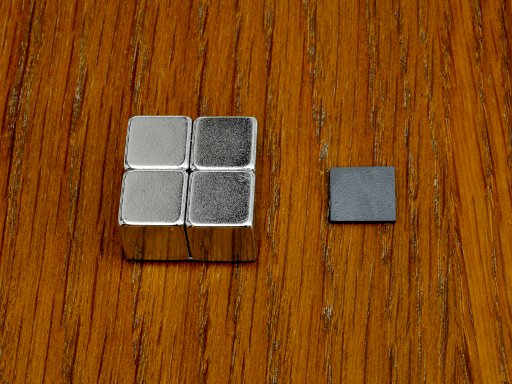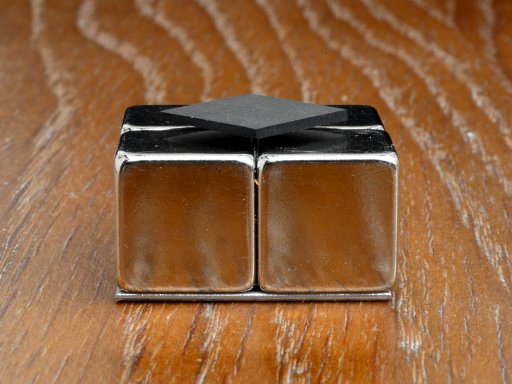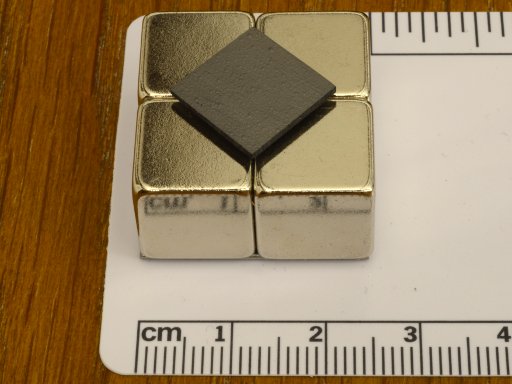« Reading List: Journals | Main | Reading List: Rockets and People. Vol. 4 »
Saturday, March 9, 2013
Levitating pyrolytic carbon
It's been a while since the last gizmo post. Here's one of the coolest things I've encountered in some time, and what's especially remarkable about it is how warm it is—it works at room temperature. Many visitors to this site are probably sufficiently nerdly to have, at some point in their lives, levitated a magnet above a piece of high-temperature superconductor, demonstrating the Meissner effect to the amazement of all onlookers. Unfortunately, “high-temperature” in this context means only that it works at the temperature of liquid nitrogen, not liquid helium, so you still have to go off to the welding supply shop with a thermos, and the experiment only works until you run out of liquid nitrogen. Amazingly, you can do a similar demonstration of levitation at room temperature by using a diamagnetic substance and a strong permanent magnet. A diamagnetic material has a magnetic permeability less than that of free space, and hence expels external magnetic fields, creating a repulsive field in response. This is usually a weak effect. Pyrolytic carbon exhibits the strongest diamagnetic effect at room temperature of any known substance. It is a form of carbon not found in nature, but which can be produced by a variety of processes. Its structure is similar to that of graphite, except there are covalent bonds between atoms in the graphene sheets of which it is composed. To the right is a small square piece of pyrolytic carbon. To the left are four
neodymium-iron-boron magnets stuck to
a steel plate at the bottom. What happens when we pick up the carbon
square and place it atop the magnets?
To the right is a small square piece of pyrolytic carbon. To the left are four
neodymium-iron-boron magnets stuck to
a steel plate at the bottom. What happens when we pick up the carbon
square and place it atop the magnets?
 Whoa! Its diamagnetism causes it to levitate above the magnets. If you perturb
it from its minimum-energy state, it will return to the centre point and the same
orientation. If you tilt the magnets slightly, the carbon square will shift to balance
the force of gravity. (If you tilt it beyond the diamagnetic restoring force, the
carbon square will fall off onto the table.). The following picture gives a sense of
scale.
Whoa! Its diamagnetism causes it to levitate above the magnets. If you perturb
it from its minimum-energy state, it will return to the centre point and the same
orientation. If you tilt the magnets slightly, the carbon square will shift to balance
the force of gravity. (If you tilt it beyond the diamagnetic restoring force, the
carbon square will fall off onto the table.). The following picture gives a sense of
scale.
 If you want to try this yourself at home, you can usually find everything you need on eBay. For some reason, you'll need to search for “pyrolytic graphite”; eBay has its own vernacular for such things. Neodymium magnets are
extraordinarily strong, and you should always be cautious when dealing with them.
Make sure you have anything magnetic far away, and never, ever allow your finger
to get between one of these magnets and something magnetic. If you want to
experiment with displacing or spinning the levitated carbon square, a wooden
toothpick is an excellent implement; a screwdriver, not so much. Also be careful how you store the magnets. They can wipe the magnetic stripes on credit
cards brought near them and erase other kinds of magnetic media. I doubt they'd
cause any problem with a hard drive within a computer, but darned if I'm going to let
them anywhere near one of my computers. I took all of these photos on a wooden table
after making sure there was nothing magnetic within two metres.
And if you have a really strong magnet, note that
frogs are diamagnetic.
If you want to try this yourself at home, you can usually find everything you need on eBay. For some reason, you'll need to search for “pyrolytic graphite”; eBay has its own vernacular for such things. Neodymium magnets are
extraordinarily strong, and you should always be cautious when dealing with them.
Make sure you have anything magnetic far away, and never, ever allow your finger
to get between one of these magnets and something magnetic. If you want to
experiment with displacing or spinning the levitated carbon square, a wooden
toothpick is an excellent implement; a screwdriver, not so much. Also be careful how you store the magnets. They can wipe the magnetic stripes on credit
cards brought near them and erase other kinds of magnetic media. I doubt they'd
cause any problem with a hard drive within a computer, but darned if I'm going to let
them anywhere near one of my computers. I took all of these photos on a wooden table
after making sure there was nothing magnetic within two metres.
And if you have a really strong magnet, note that
frogs are diamagnetic.
Posted at March 9, 2013 21:36